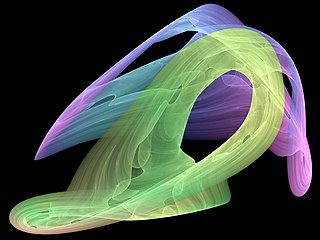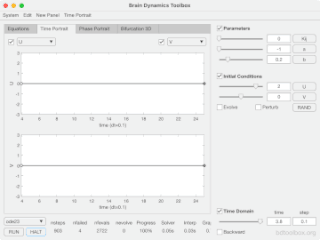Roots of cybernetical physics
Until recently no creative interaction of physics and control theory (cybernetics) had been seen and no control theory methods were directly used for discovering new physical effects and phenomena. The situation dramatically changed in the 1990s when two new areas emerged: control of chaos and quantum control.
Control of chaos
In 1990 a paper [1] was published in Physical Review Letters by Edward Ott, Celso Grebogi and James Yorke from the University of Maryland reporting that even small feedback action can dramatically change the behavior of a nonlinear system, e.g., turn chaotic motions into periodic ones and vice versa. The idea almost immediately became popular in the physics community, and since 1990 hundreds of papers have been published demonstrating the ability of small control, with or without feedback, to significantly change the dynamics of real or model systems. By 2003, this paper by Ott, Grebogi and Yorke [1] had been quoted over 1300 times whilst the total number of papers relating to control of chaos exceeded 4000 by the beginning of the 21st century, with 300-400 papers per year being published in peer reviewed journals. The method proposed in [1] is now called the OGY-method after the authors' initials.
Later, a number of other methods were proposed for transforming chaotic trajectories into periodic ones, for example delayed feedback (Pyragas method). [2] Numerous nonlinear and adaptive control methods were also applied for the control of chaos, see surveys in. [3] [4] [5] [6]
It is important that the results obtained were interpreted as discovering new properties of physical systems. Thousands of papers were published that examine and predict properties of systems based on the use of control, identification and other cybernetic methods. Notably, most of those papers were published in physical journals, their authors representing university physics departments. It has become clear that such types of control goals are important not only for the control of chaos, but also for the control of a broader class of oscillatory processes. This provides evidence for the existence of an emerging field of research related to both physics and control, that of "cybernetical physics". [7] [8]
Quantum control
It is conceivable that molecular physics was the area where ideas of control first appeared. James Clerk Maxwell introduced a hypothetical being, known as Maxwell's Demon, with the ability to measure the velocities of gas molecules in a vessel and to direct the fast molecules to one part of the vessel while keeping the slow molecules in another part. This produces a temperature difference between the two parts of the vessel, which seems to contradict the Second Law of Thermodynamics. Now, after more than a century of fruitful life, this demon is even more active than in the past. Recent papers discussed issues relating to the experimental implementation of Maxwell's Demon, particularly at the quantum-mechanical level. [9]
At the end of the 1970s the first mathematical results for the control of quantum mechanical models appeared based on control theory [10] At the end of the 1980s and beginning of the 1990s rapid developments in the laser industry led to the appearance of ultrafast, so-called femtosecond lasers. This new generation of lasers has the ability to generate pulses with durations of a few femtoseconds and even less (1 fs = sec). The duration of such a pulse is comparable with the period of a molecule's natural oscillation. Therefore, a femtosecond laser can, in principle, be used as a mean of controlling single molecules and atoms. A consequence of such an application is the possibility of realizing the alchemists' dream of changing the natural course of chemical reactions. A new area in chemistry emerged, femtochemistry, and new femtotechnologies were developed. Ahmed Zewail from Caltech was awarded the 1999 Nobel Prize in Chemistry for his work on femtochemistry.
Using modern control theory, new horizons may open for studying the interaction of atoms and molecules, and new ways and possible limits may be discovered for intervening in the intimate processes of the microworld. Besides, control is an important part of many recent nanoscale applications, including nanomotors, nanowires, nanochips, nanorobots, etc. The number of publications in peer reviewed journals exceeds 600 per year.
Control thermodynamics
The basics of thermodynamics were stated by Sadi Carnot in 1824. He considered a heat engine which operates by drawing heat from a source which is at thermal equilibrium at temperature , and delivering useful work. Carnot saw that, in order to operate continuously, the engine requires also a cold reservoir with the temperature , to which some heat can be discharged. By simple logic he established the famous ‘’’Carnot Principle’’’: ‘’No heat engine can be more efficient than a reversible one operating between the same temperatures’’.
In fact it was nothing but the solution to an optimal control problem: maximum work can be extracted by a reversible machine and the value of extracted work depends only on the temperatures of the source and the bath. Later, Kelvin introduced his absolute temperature scale (Kelvin scale) and accomplished the next step, evaluating Carnot's reversible efficiency However, most work was devoted to studying stationary systems over infinite time intervals, while for practical purposes it is important to know the possibilities and limitations of the system's evolution for finite times as well as under other types of constraints caused by a finite amount of available resources.
The pioneer work devoted to evaluating finite time limitations for heat engines was published by I. Novikov in 1957, [11] and independently by F.L. Curzon and B. Ahlborn in 1975: [12] the efficiency at maximum power per cycle of a heat engine coupled to its surroundings through a constant heat conductor is (the Novikov-Curzon-Ahlborn formula). The Novikov-Curzon-Ahlborn process is also optimal in the sense of minimal dissipation. Otherwise, if the dissipation degree is given, the process corresponds to the maximum entropy principle. Later, the results [12] [11] were extended and generalized for other criteria and for more complex situations based on modern optimal control theory. As a result, a new direction in thermodynamics arose known under the names "optimization thermodynamics", "finite-time thermodynamics", Endoreversible thermodynamics or "control thermodynamics", see. [13]




















